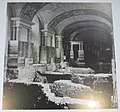Lescot Wing
48°51′36.95″N 2°20′15.08″E / 48.8602639°N 2.3375222°E

The Lescot Wing (Aile Lescot in
King Francis I appointed architect Pierre Lescot (1510–1578) to lead all building projects at the Louvre Palace. Lescot's role was reconfirmed following Francis's death by his son and successor Henry II; Lescot kept working on the Louvre project until his death, completing the Lescot Wing in 1551, the Pavillon du Roi, and the western section of the southern wing of the Cour Carrée.
Exterior
The wing's façade on the court side, now the
The eastern façade was comprehensively renovated in the early 1980s and inaugurated by President François Mitterrand, together with the rest of the cleaned-up Cour Carrée, on 24 February 1986.
-
Lescot's façade illustrated in Les Plus Excellents Bâtiments de France (1576) by Jacques I Androuet du Cerceau
-
Detail of ground floor's decoration, as illuminated by night
-
Water, by Goujon
-
Ceres, by Goujon
-
Mars, by Goujon
-
Central pediment by Goujon: two angels bearing Henry II's monogram
-
Bellona, by Goujon
-
Archimedes, by Goujon
-
Euclid, by Goujon
Interior
Both the ground floor and the first floor include major ceremonial spaces or
Ground floor
The Lower Great Hall (Grande Salle basse), now known as Hall of the
First floor
The Upper Great Hall (Grande Salle haute), long known as the Salle La Caze as it hosted the collection donated by
To the south of the Upper Great Hall were two rooms leading to the Pavillon du Roi, a wardrobe and an antechamber, which were merged into a single King's antechamber (French: antichambre du Roi) in 1660, where Louis XIV used to dine in public.[7] That room still displays its ornate carved ceiling, the central section of which was originally the ceiling of the 16th-century antechamber and was complemented by two side sections in the same style during the 1660 enlargement. The ceiling reserves three spaces for paintings, which were decorated in 1822 with works by Merry-Joseph Blondel.[2]: 75 These were in turn deposed in 1938 and replaced in 1953 with Les Oiseaux, a set of paintings by Georges Braque that marked the first installation of contemporary art in the Louvre for more than half a century.[8]
Second floor
The attic served as lodgings for high-ranking officials and courtiers until its suppression in the early 19th century. In the 1650s it was inhabited by Cardinal Mazarin's nieces. Since 1993 it has been dedicated to the exhibition of 19th-century French paintings.
Staircases
To the immediate north of these spaces is the Lescot Wing's ceremonial staircase, mostly preserved in its mid-16th-century state, known in the past as the grand degré du Roi and now as the escalier Henri II. Its vaulted stone ceiling is decorated with ornate motifs designed by Jean Goujon.[9]: 11–13 Immediately to the north is the Pavillon de l'Horloge, built between 1624 and 1643 and served by that staircase and its symmetrical counterpart on the other side, known as escalier Henri IV (which is anachronistic, since it was only started in 1639 and left unfinished during the Fronde).[9]: 13
Two smaller
-
The Caryatids' Tribune in the Lower Great Hall, illustrated in Les Plus Excellents Bâtiments de France (1576) by Jacques I Androuet du Cerceau
-
View of the Lower Great Hall across the "tribunal" in 1785, byCount of Angiviller
-
Inaugural session of the Institut de France in 1795, engraving by Abraham Girardet
-
Fireplace of the "tribunal" created in the early 1800s, reusing sculpted elements from Goujon's time
-
Early photograph of the Lower Great Hall, ca. 1851, by Charles Marville
-
Excavation of theMedieval Louvre(initiated to install heating) under the Lower Great Hall, 1882
-
Lower Great Hall in the early 20C
-
The Lower Great Hall's caryatids in 2014
-
The Upper Great Hall in 1866, shortly after Lefuel's transformation
-
Upper Great Hall in 2012, with 1936 layout and Cy Twombly's 2010 roof painting
-
Upper Great Hall following redecoration in 2021
-
Ceiling of the ceremonial staircase
See also
Notes
- ^ John Summerson (1963). The Classical Language of Architecture. London and New York City: Thames & Hudson. p. 76.
- ^ a b c d e Jacques Hillairet. Dictionnaire historique des rues de Paris. Vol. II. Paris: Editions de Minuit.
- ^ a b Guillaume Fonkenell (2018). Le Louvre : Le palais à travers les siècles. Paris: Honoré Clair / Louvre éditions.
- ^ Christiane Aulanier (1952). Les Trois Salles des Etats (PDF). Paris: Editions des Musées Nationaux.
- ^ Doreen Carvajal (5 March 2021). "Palace Intrigue at the Louvre, as a Paint Job Leads to a Lawsuit". New York Times.
- ^ Clara Baudry (14 December 2021). "Au musée du Louvre, fin de la discorde autour du plafond peint par Cy Twombly". Connaissance des arts.
- ^ Hugh Murray Baillie (1967), "Etiquette and the Planning of the State Apartments in Baroque Palaces", Archaeologia, 101, Society of Antiquaries of London
- ^ Devorah Lauter (27 March 2010). "Hitting the Louvre ceiling". Los Angeles Times.
- ^ a b Christiane Aulanier (1964). Le Pavillon de l'Horloge et le Département des Antiquités Orientales (PDF). Paris: Editions des Musées Nationaux.





















